BUACC5933 - Corporate Governance and Financial Reporting Analysis 2018
VerifiedAdded on 2023/06/12
|6
|2009
|310
Essay
AI Summary
This essay discusses the importance of financial reporting under IFRS and other standards, ensuring stakeholders receive accurate information for decision-making. It highlights corporate governance issues, using examples like Enron and WorldCom to illustrate the consequences of poor governance and fraudulent reporting. The essay emphasizes that good corporate governance is essential for balancing stakeholder interests, preventing corruption, and maintaining market credibility. It also addresses the challenges faced by boards of directors, particularly external members, in accessing and utilizing information effectively. The conclusion stresses that optimal information flow is crucial for resource utilization, sustainable growth, and maximizing stockholder interests. Access the full solution on Desklib, where you can find past papers and solved assignments.

BUACC5933 – Cost and
Management Accounting
Semester 1 2018
Management Accounting
Semester 1 2018
Paraphrase This Document
Need a fresh take? Get an instant paraphrase of this document with our AI Paraphraser
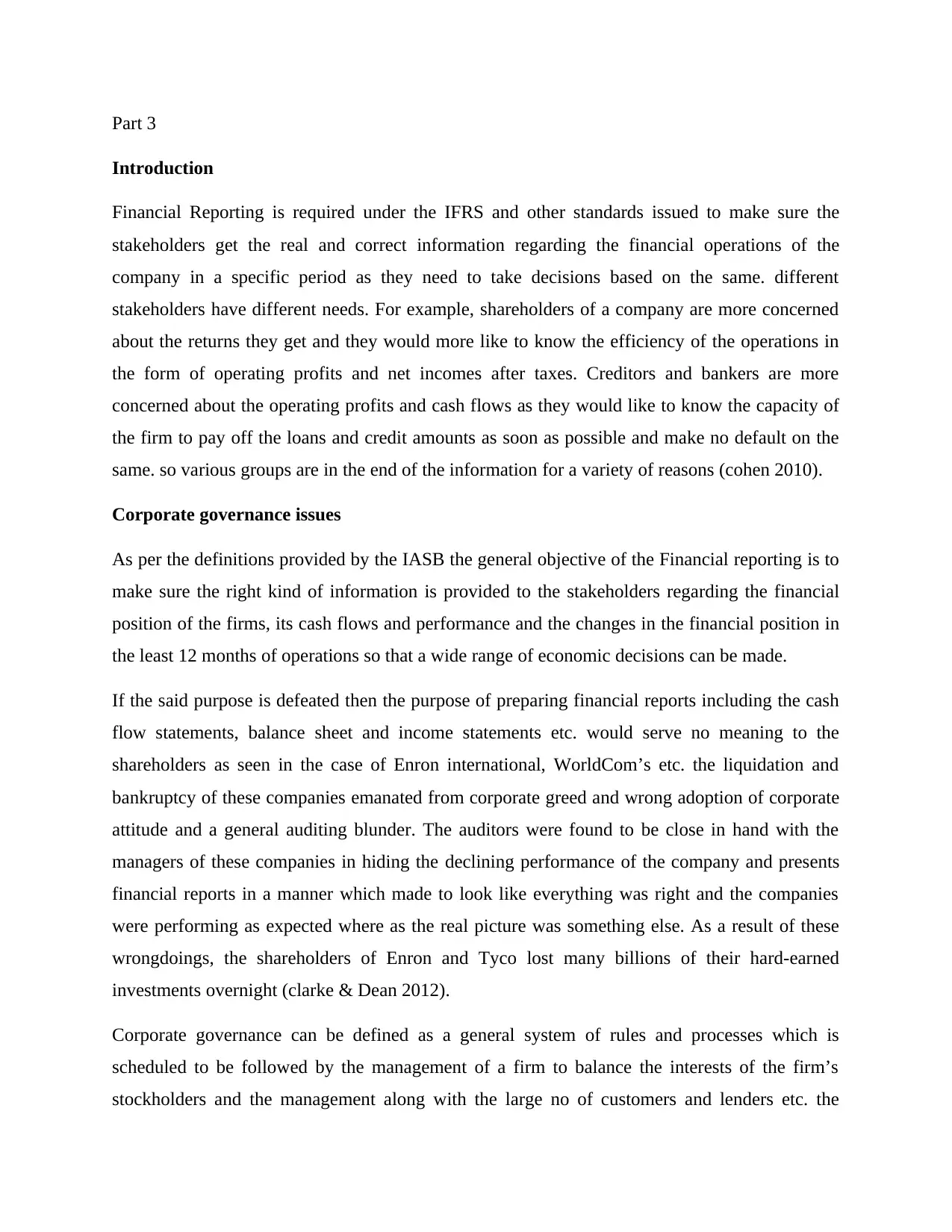
Part 3
Introduction
Financial Reporting is required under the IFRS and other standards issued to make sure the
stakeholders get the real and correct information regarding the financial operations of the
company in a specific period as they need to take decisions based on the same. different
stakeholders have different needs. For example, shareholders of a company are more concerned
about the returns they get and they would more like to know the efficiency of the operations in
the form of operating profits and net incomes after taxes. Creditors and bankers are more
concerned about the operating profits and cash flows as they would like to know the capacity of
the firm to pay off the loans and credit amounts as soon as possible and make no default on the
same. so various groups are in the end of the information for a variety of reasons (cohen 2010).
Corporate governance issues
As per the definitions provided by the IASB the general objective of the Financial reporting is to
make sure the right kind of information is provided to the stakeholders regarding the financial
position of the firms, its cash flows and performance and the changes in the financial position in
the least 12 months of operations so that a wide range of economic decisions can be made.
If the said purpose is defeated then the purpose of preparing financial reports including the cash
flow statements, balance sheet and income statements etc. would serve no meaning to the
shareholders as seen in the case of Enron international, WorldCom’s etc. the liquidation and
bankruptcy of these companies emanated from corporate greed and wrong adoption of corporate
attitude and a general auditing blunder. The auditors were found to be close in hand with the
managers of these companies in hiding the declining performance of the company and presents
financial reports in a manner which made to look like everything was right and the companies
were performing as expected where as the real picture was something else. As a result of these
wrongdoings, the shareholders of Enron and Tyco lost many billions of their hard-earned
investments overnight (clarke & Dean 2012).
Corporate governance can be defined as a general system of rules and processes which is
scheduled to be followed by the management of a firm to balance the interests of the firm’s
stockholders and the management along with the large no of customers and lenders etc. the
Introduction
Financial Reporting is required under the IFRS and other standards issued to make sure the
stakeholders get the real and correct information regarding the financial operations of the
company in a specific period as they need to take decisions based on the same. different
stakeholders have different needs. For example, shareholders of a company are more concerned
about the returns they get and they would more like to know the efficiency of the operations in
the form of operating profits and net incomes after taxes. Creditors and bankers are more
concerned about the operating profits and cash flows as they would like to know the capacity of
the firm to pay off the loans and credit amounts as soon as possible and make no default on the
same. so various groups are in the end of the information for a variety of reasons (cohen 2010).
Corporate governance issues
As per the definitions provided by the IASB the general objective of the Financial reporting is to
make sure the right kind of information is provided to the stakeholders regarding the financial
position of the firms, its cash flows and performance and the changes in the financial position in
the least 12 months of operations so that a wide range of economic decisions can be made.
If the said purpose is defeated then the purpose of preparing financial reports including the cash
flow statements, balance sheet and income statements etc. would serve no meaning to the
shareholders as seen in the case of Enron international, WorldCom’s etc. the liquidation and
bankruptcy of these companies emanated from corporate greed and wrong adoption of corporate
attitude and a general auditing blunder. The auditors were found to be close in hand with the
managers of these companies in hiding the declining performance of the company and presents
financial reports in a manner which made to look like everything was right and the companies
were performing as expected where as the real picture was something else. As a result of these
wrongdoings, the shareholders of Enron and Tyco lost many billions of their hard-earned
investments overnight (clarke & Dean 2012).
Corporate governance can be defined as a general system of rules and processes which is
scheduled to be followed by the management of a firm to balance the interests of the firm’s
stockholders and the management along with the large no of customers and lenders etc. the
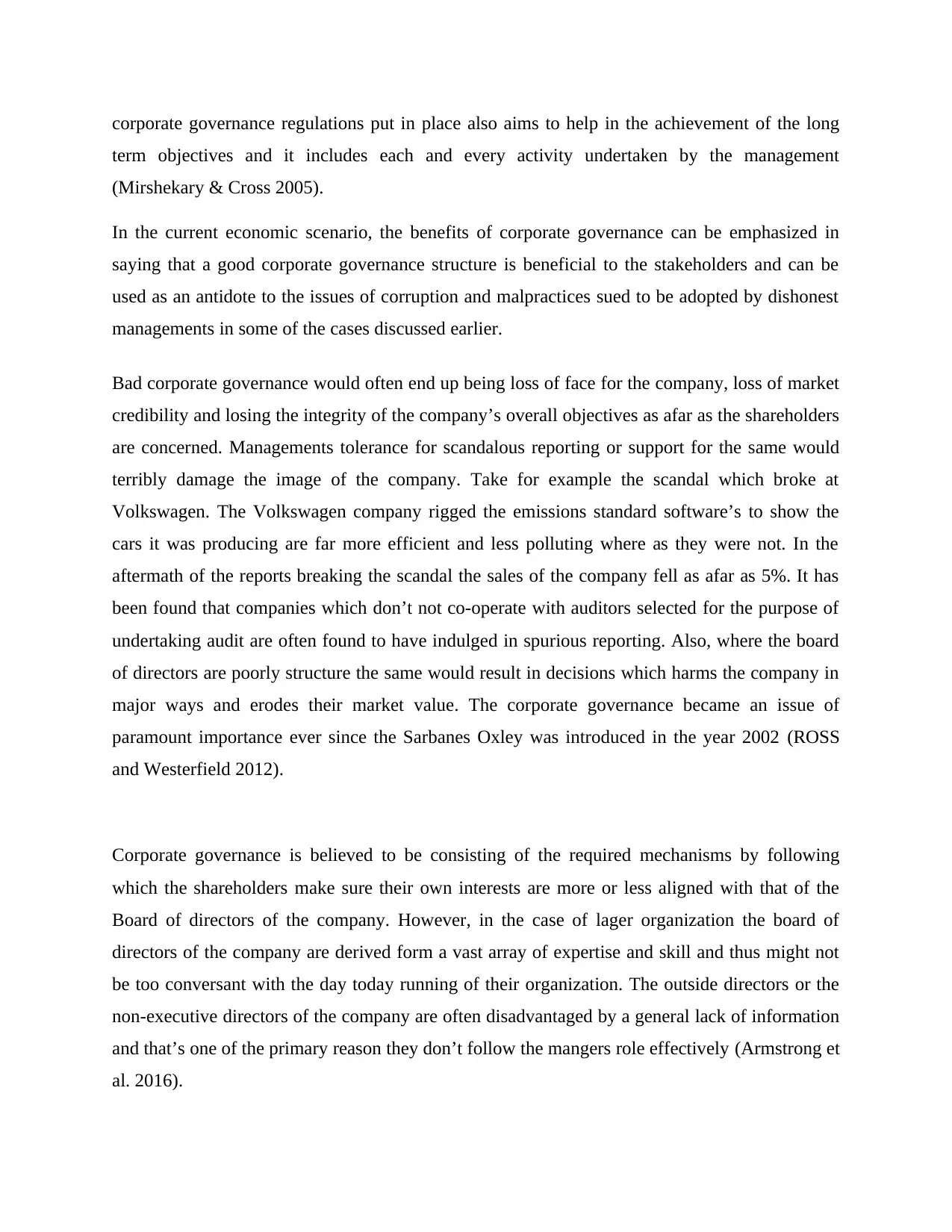
corporate governance regulations put in place also aims to help in the achievement of the long
term objectives and it includes each and every activity undertaken by the management
(Mirshekary & Cross 2005).
In the current economic scenario, the benefits of corporate governance can be emphasized in
saying that a good corporate governance structure is beneficial to the stakeholders and can be
used as an antidote to the issues of corruption and malpractices sued to be adopted by dishonest
managements in some of the cases discussed earlier.
Bad corporate governance would often end up being loss of face for the company, loss of market
credibility and losing the integrity of the company’s overall objectives as afar as the shareholders
are concerned. Managements tolerance for scandalous reporting or support for the same would
terribly damage the image of the company. Take for example the scandal which broke at
Volkswagen. The Volkswagen company rigged the emissions standard software’s to show the
cars it was producing are far more efficient and less polluting where as they were not. In the
aftermath of the reports breaking the scandal the sales of the company fell as afar as 5%. It has
been found that companies which don’t not co-operate with auditors selected for the purpose of
undertaking audit are often found to have indulged in spurious reporting. Also, where the board
of directors are poorly structure the same would result in decisions which harms the company in
major ways and erodes their market value. The corporate governance became an issue of
paramount importance ever since the Sarbanes Oxley was introduced in the year 2002 (ROSS
and Westerfield 2012).
Corporate governance is believed to be consisting of the required mechanisms by following
which the shareholders make sure their own interests are more or less aligned with that of the
Board of directors of the company. However, in the case of lager organization the board of
directors of the company are derived form a vast array of expertise and skill and thus might not
be too conversant with the day today running of their organization. The outside directors or the
non-executive directors of the company are often disadvantaged by a general lack of information
and that’s one of the primary reason they don’t follow the mangers role effectively (Armstrong et
al. 2016).
term objectives and it includes each and every activity undertaken by the management
(Mirshekary & Cross 2005).
In the current economic scenario, the benefits of corporate governance can be emphasized in
saying that a good corporate governance structure is beneficial to the stakeholders and can be
used as an antidote to the issues of corruption and malpractices sued to be adopted by dishonest
managements in some of the cases discussed earlier.
Bad corporate governance would often end up being loss of face for the company, loss of market
credibility and losing the integrity of the company’s overall objectives as afar as the shareholders
are concerned. Managements tolerance for scandalous reporting or support for the same would
terribly damage the image of the company. Take for example the scandal which broke at
Volkswagen. The Volkswagen company rigged the emissions standard software’s to show the
cars it was producing are far more efficient and less polluting where as they were not. In the
aftermath of the reports breaking the scandal the sales of the company fell as afar as 5%. It has
been found that companies which don’t not co-operate with auditors selected for the purpose of
undertaking audit are often found to have indulged in spurious reporting. Also, where the board
of directors are poorly structure the same would result in decisions which harms the company in
major ways and erodes their market value. The corporate governance became an issue of
paramount importance ever since the Sarbanes Oxley was introduced in the year 2002 (ROSS
and Westerfield 2012).
Corporate governance is believed to be consisting of the required mechanisms by following
which the shareholders make sure their own interests are more or less aligned with that of the
Board of directors of the company. However, in the case of lager organization the board of
directors of the company are derived form a vast array of expertise and skill and thus might not
be too conversant with the day today running of their organization. The outside directors or the
non-executive directors of the company are often disadvantaged by a general lack of information
and that’s one of the primary reason they don’t follow the mangers role effectively (Armstrong et
al. 2016).
⊘ This is a preview!⊘
Do you want full access?
Subscribe today to unlock all pages.

Trusted by 1+ million students worldwide
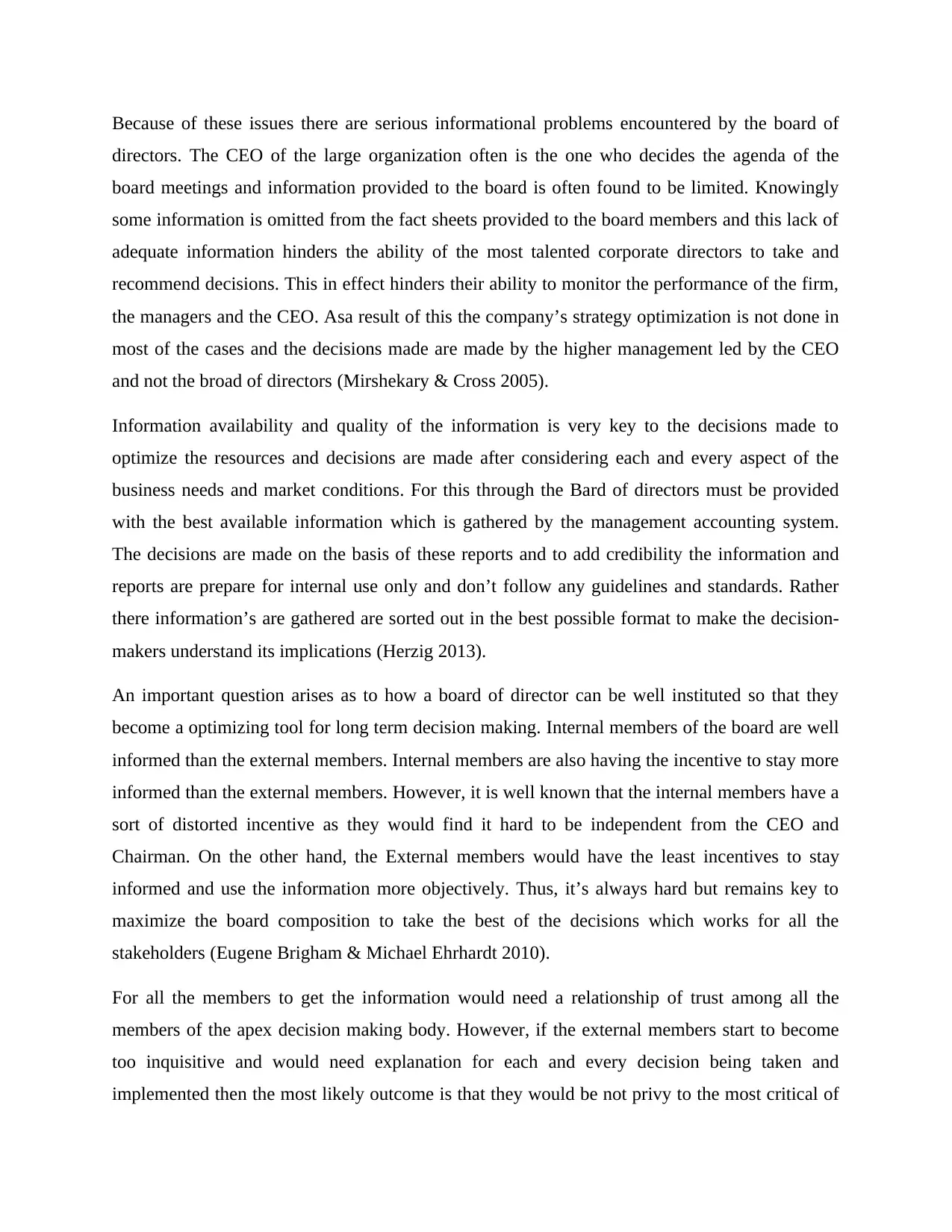
Because of these issues there are serious informational problems encountered by the board of
directors. The CEO of the large organization often is the one who decides the agenda of the
board meetings and information provided to the board is often found to be limited. Knowingly
some information is omitted from the fact sheets provided to the board members and this lack of
adequate information hinders the ability of the most talented corporate directors to take and
recommend decisions. This in effect hinders their ability to monitor the performance of the firm,
the managers and the CEO. Asa result of this the company’s strategy optimization is not done in
most of the cases and the decisions made are made by the higher management led by the CEO
and not the broad of directors (Mirshekary & Cross 2005).
Information availability and quality of the information is very key to the decisions made to
optimize the resources and decisions are made after considering each and every aspect of the
business needs and market conditions. For this through the Bard of directors must be provided
with the best available information which is gathered by the management accounting system.
The decisions are made on the basis of these reports and to add credibility the information and
reports are prepare for internal use only and don’t follow any guidelines and standards. Rather
there information’s are gathered are sorted out in the best possible format to make the decision-
makers understand its implications (Herzig 2013).
An important question arises as to how a board of director can be well instituted so that they
become a optimizing tool for long term decision making. Internal members of the board are well
informed than the external members. Internal members are also having the incentive to stay more
informed than the external members. However, it is well known that the internal members have a
sort of distorted incentive as they would find it hard to be independent from the CEO and
Chairman. On the other hand, the External members would have the least incentives to stay
informed and use the information more objectively. Thus, it’s always hard but remains key to
maximize the board composition to take the best of the decisions which works for all the
stakeholders (Eugene Brigham & Michael Ehrhardt 2010).
For all the members to get the information would need a relationship of trust among all the
members of the apex decision making body. However, if the external members start to become
too inquisitive and would need explanation for each and every decision being taken and
implemented then the most likely outcome is that they would be not privy to the most critical of
directors. The CEO of the large organization often is the one who decides the agenda of the
board meetings and information provided to the board is often found to be limited. Knowingly
some information is omitted from the fact sheets provided to the board members and this lack of
adequate information hinders the ability of the most talented corporate directors to take and
recommend decisions. This in effect hinders their ability to monitor the performance of the firm,
the managers and the CEO. Asa result of this the company’s strategy optimization is not done in
most of the cases and the decisions made are made by the higher management led by the CEO
and not the broad of directors (Mirshekary & Cross 2005).
Information availability and quality of the information is very key to the decisions made to
optimize the resources and decisions are made after considering each and every aspect of the
business needs and market conditions. For this through the Bard of directors must be provided
with the best available information which is gathered by the management accounting system.
The decisions are made on the basis of these reports and to add credibility the information and
reports are prepare for internal use only and don’t follow any guidelines and standards. Rather
there information’s are gathered are sorted out in the best possible format to make the decision-
makers understand its implications (Herzig 2013).
An important question arises as to how a board of director can be well instituted so that they
become a optimizing tool for long term decision making. Internal members of the board are well
informed than the external members. Internal members are also having the incentive to stay more
informed than the external members. However, it is well known that the internal members have a
sort of distorted incentive as they would find it hard to be independent from the CEO and
Chairman. On the other hand, the External members would have the least incentives to stay
informed and use the information more objectively. Thus, it’s always hard but remains key to
maximize the board composition to take the best of the decisions which works for all the
stakeholders (Eugene Brigham & Michael Ehrhardt 2010).
For all the members to get the information would need a relationship of trust among all the
members of the apex decision making body. However, if the external members start to become
too inquisitive and would need explanation for each and every decision being taken and
implemented then the most likely outcome is that they would be not privy to the most critical of
Paraphrase This Document
Need a fresh take? Get an instant paraphrase of this document with our AI Paraphraser
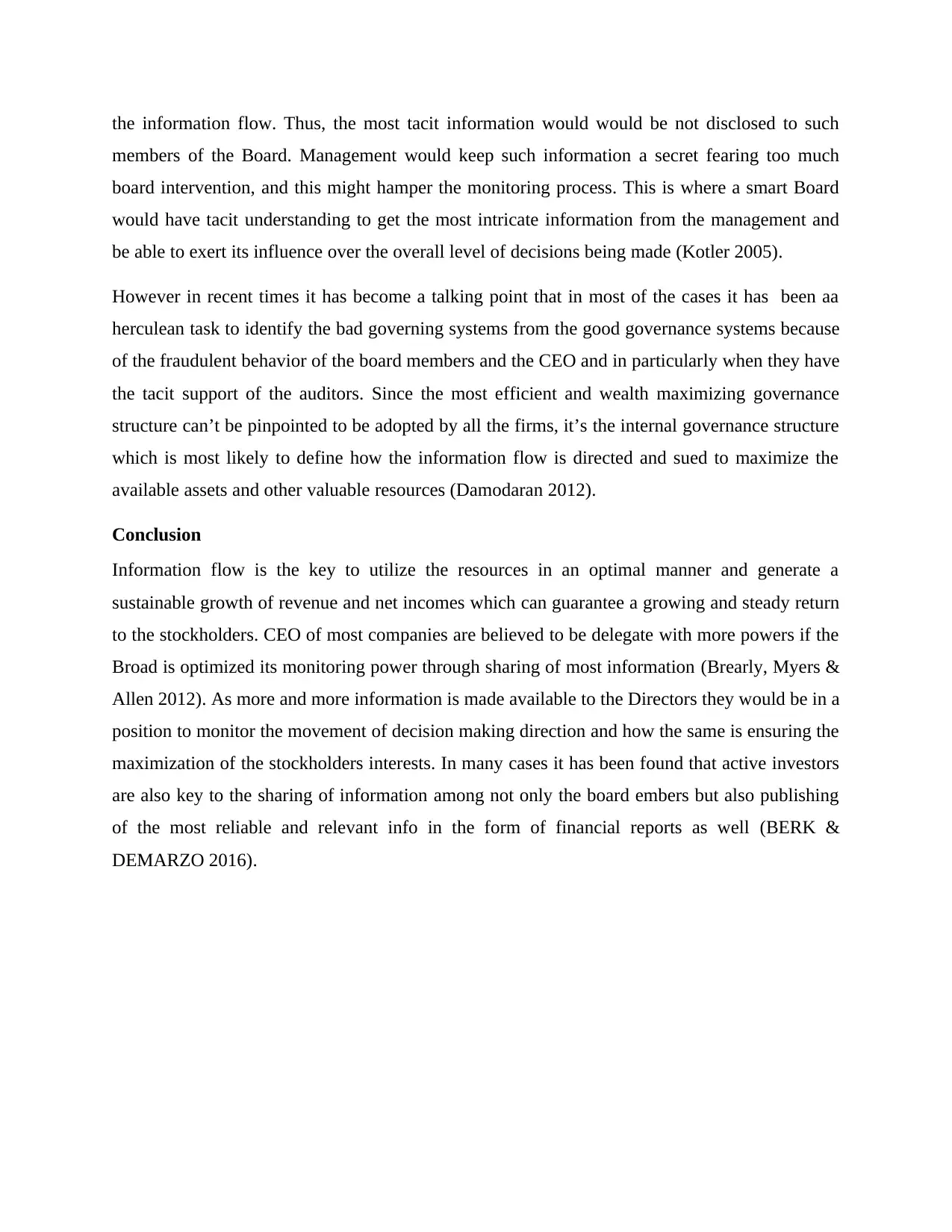
the information flow. Thus, the most tacit information would would be not disclosed to such
members of the Board. Management would keep such information a secret fearing too much
board intervention, and this might hamper the monitoring process. This is where a smart Board
would have tacit understanding to get the most intricate information from the management and
be able to exert its influence over the overall level of decisions being made (Kotler 2005).
However in recent times it has become a talking point that in most of the cases it has been aa
herculean task to identify the bad governing systems from the good governance systems because
of the fraudulent behavior of the board members and the CEO and in particularly when they have
the tacit support of the auditors. Since the most efficient and wealth maximizing governance
structure can’t be pinpointed to be adopted by all the firms, it’s the internal governance structure
which is most likely to define how the information flow is directed and sued to maximize the
available assets and other valuable resources (Damodaran 2012).
Conclusion
Information flow is the key to utilize the resources in an optimal manner and generate a
sustainable growth of revenue and net incomes which can guarantee a growing and steady return
to the stockholders. CEO of most companies are believed to be delegate with more powers if the
Broad is optimized its monitoring power through sharing of most information (Brearly, Myers &
Allen 2012). As more and more information is made available to the Directors they would be in a
position to monitor the movement of decision making direction and how the same is ensuring the
maximization of the stockholders interests. In many cases it has been found that active investors
are also key to the sharing of information among not only the board embers but also publishing
of the most reliable and relevant info in the form of financial reports as well (BERK &
DEMARZO 2016).
members of the Board. Management would keep such information a secret fearing too much
board intervention, and this might hamper the monitoring process. This is where a smart Board
would have tacit understanding to get the most intricate information from the management and
be able to exert its influence over the overall level of decisions being made (Kotler 2005).
However in recent times it has become a talking point that in most of the cases it has been aa
herculean task to identify the bad governing systems from the good governance systems because
of the fraudulent behavior of the board members and the CEO and in particularly when they have
the tacit support of the auditors. Since the most efficient and wealth maximizing governance
structure can’t be pinpointed to be adopted by all the firms, it’s the internal governance structure
which is most likely to define how the information flow is directed and sued to maximize the
available assets and other valuable resources (Damodaran 2012).
Conclusion
Information flow is the key to utilize the resources in an optimal manner and generate a
sustainable growth of revenue and net incomes which can guarantee a growing and steady return
to the stockholders. CEO of most companies are believed to be delegate with more powers if the
Broad is optimized its monitoring power through sharing of most information (Brearly, Myers &
Allen 2012). As more and more information is made available to the Directors they would be in a
position to monitor the movement of decision making direction and how the same is ensuring the
maximization of the stockholders interests. In many cases it has been found that active investors
are also key to the sharing of information among not only the board embers but also publishing
of the most reliable and relevant info in the form of financial reports as well (BERK &
DEMARZO 2016).
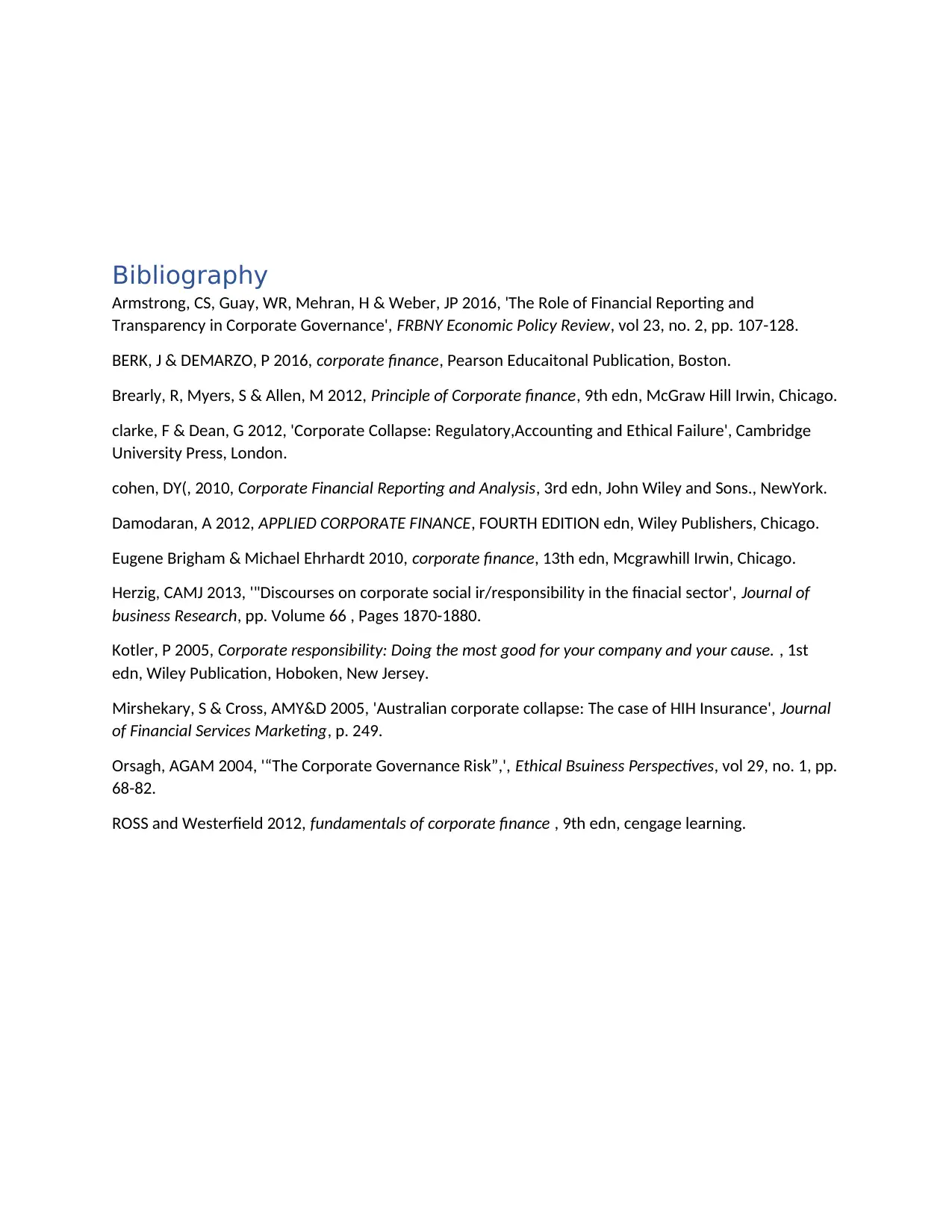
Bibliography
Armstrong, CS, Guay, WR, Mehran, H & Weber, JP 2016, 'The Role of Financial Reporting and
Transparency in Corporate Governance', FRBNY Economic Policy Review, vol 23, no. 2, pp. 107-128.
BERK, J & DEMARZO, P 2016, corporate finance, Pearson Educaitonal Publication, Boston.
Brearly, R, Myers, S & Allen, M 2012, Principle of Corporate finance, 9th edn, McGraw Hill Irwin, Chicago.
clarke, F & Dean, G 2012, 'Corporate Collapse: Regulatory,Accounting and Ethical Failure', Cambridge
University Press, London.
cohen, DY(, 2010, Corporate Financial Reporting and Analysis, 3rd edn, John Wiley and Sons., NewYork.
Damodaran, A 2012, APPLIED CORPORATE FINANCE, FOURTH EDITION edn, Wiley Publishers, Chicago.
Eugene Brigham & Michael Ehrhardt 2010, corporate finance, 13th edn, Mcgrawhill Irwin, Chicago.
Herzig, CAMJ 2013, '"Discourses on corporate social ir/responsibility in the finacial sector', Journal of
business Research, pp. Volume 66 , Pages 1870-1880.
Kotler, P 2005, Corporate responsibility: Doing the most good for your company and your cause. , 1st
edn, Wiley Publication, Hoboken, New Jersey.
Mirshekary, S & Cross, AMY&D 2005, 'Australian corporate collapse: The case of HIH Insurance', Journal
of Financial Services Marketing, p. 249.
Orsagh, AGAM 2004, '“The Corporate Governance Risk”,', Ethical Bsuiness Perspectives, vol 29, no. 1, pp.
68-82.
ROSS and Westerfield 2012, fundamentals of corporate finance , 9th edn, cengage learning.
Armstrong, CS, Guay, WR, Mehran, H & Weber, JP 2016, 'The Role of Financial Reporting and
Transparency in Corporate Governance', FRBNY Economic Policy Review, vol 23, no. 2, pp. 107-128.
BERK, J & DEMARZO, P 2016, corporate finance, Pearson Educaitonal Publication, Boston.
Brearly, R, Myers, S & Allen, M 2012, Principle of Corporate finance, 9th edn, McGraw Hill Irwin, Chicago.
clarke, F & Dean, G 2012, 'Corporate Collapse: Regulatory,Accounting and Ethical Failure', Cambridge
University Press, London.
cohen, DY(, 2010, Corporate Financial Reporting and Analysis, 3rd edn, John Wiley and Sons., NewYork.
Damodaran, A 2012, APPLIED CORPORATE FINANCE, FOURTH EDITION edn, Wiley Publishers, Chicago.
Eugene Brigham & Michael Ehrhardt 2010, corporate finance, 13th edn, Mcgrawhill Irwin, Chicago.
Herzig, CAMJ 2013, '"Discourses on corporate social ir/responsibility in the finacial sector', Journal of
business Research, pp. Volume 66 , Pages 1870-1880.
Kotler, P 2005, Corporate responsibility: Doing the most good for your company and your cause. , 1st
edn, Wiley Publication, Hoboken, New Jersey.
Mirshekary, S & Cross, AMY&D 2005, 'Australian corporate collapse: The case of HIH Insurance', Journal
of Financial Services Marketing, p. 249.
Orsagh, AGAM 2004, '“The Corporate Governance Risk”,', Ethical Bsuiness Perspectives, vol 29, no. 1, pp.
68-82.
ROSS and Westerfield 2012, fundamentals of corporate finance , 9th edn, cengage learning.
⊘ This is a preview!⊘
Do you want full access?
Subscribe today to unlock all pages.

Trusted by 1+ million students worldwide
1 out of 6
Related Documents
Your All-in-One AI-Powered Toolkit for Academic Success.
+13062052269
info@desklib.com
Available 24*7 on WhatsApp / Email
![[object Object]](/_next/static/media/star-bottom.7253800d.svg)
Unlock your academic potential
Copyright © 2020–2025 A2Z Services. All Rights Reserved. Developed and managed by ZUCOL.





